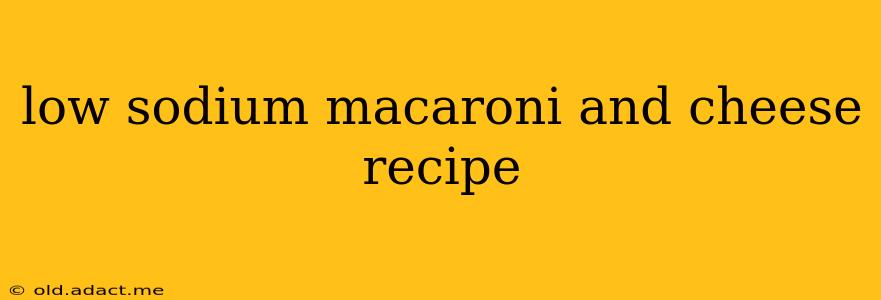Macaroni and cheese, a comfort food staple, often gets a bad rap for its high sodium content. But fear not, cheese lovers! This recipe shows you how to create a creamy, cheesy, and satisfying macaroni and cheese with significantly less sodium, without sacrificing any of the flavor. We'll explore ways to reduce sodium while maintaining that rich, decadent texture you crave. This recipe is perfect for those watching their sodium intake due to health concerns or simply seeking a healthier alternative to traditional mac and cheese.
What Makes This Mac and Cheese Low Sodium?
The key to a low-sodium mac and cheese lies in mindful ingredient selection and preparation. We'll be using low-sodium or no-salt-added ingredients wherever possible. This includes:
- Low-sodium broth or milk: Regular milk and broth are surprisingly high in sodium. Switching to low-sodium or no-salt-added versions makes a significant difference.
- Reduced-sodium cheeses: Many cheeses are available in reduced-sodium varieties. Look for these in your grocery store's dairy section. You can also blend different types of cheeses to achieve the desired flavor profile and creaminess.
- Fresh herbs and spices: Instead of relying on salt for flavor, we'll enhance the taste with fresh herbs like parsley, chives, or thyme, and spices such as garlic powder, onion powder, or paprika. These additions add depth and complexity without adding sodium.
- Careful seasoning: We'll taste and adjust seasonings throughout the cooking process, ensuring the flavor is balanced without over-salting.
Low-Sodium Macaroni and Cheese Recipe
Yields: 6 servings Prep time: 10 minutes Cook time: 20 minutes
Ingredients:
- 1 pound elbow macaroni
- 4 tablespoons unsalted butter
- 1/4 cup all-purpose flour
- 3 cups low-sodium milk (or a combination of milk and low-sodium broth)
- 2 cups shredded reduced-sodium cheddar cheese
- 1 cup shredded reduced-sodium Monterey Jack cheese
- 1/4 cup grated Parmesan cheese (reduced-sodium, if possible)
- 1 teaspoon garlic powder
- 1/2 teaspoon onion powder
- 1/4 teaspoon paprika
- 1/4 cup chopped fresh parsley (optional)
- Black pepper to taste
Instructions:
- Cook the pasta: Cook the macaroni according to package directions until al dente. Drain and set aside.
- Make the cheese sauce: Melt the butter in a large saucepan over medium heat. Whisk in the flour and cook for 1-2 minutes, stirring constantly, until smooth. Gradually whisk in the milk (or milk/broth mixture), stirring constantly until the sauce thickens.
- Add the cheese and seasonings: Reduce the heat to low. Stir in the cheddar, Monterey Jack, and Parmesan cheeses until melted and smooth. Stir in the garlic powder, onion powder, paprika, and black pepper.
- Combine pasta and sauce: Add the cooked macaroni to the cheese sauce and stir to coat evenly.
- Serve: Garnish with fresh parsley, if desired. Serve immediately and enjoy!
Frequently Asked Questions (FAQ)
Can I use different types of cheese?
Absolutely! Experiment with other reduced-sodium cheeses like Colby, Gruyère, or a blend of your favorites. The key is to find cheeses that melt well and complement each other.
How can I make this recipe even healthier?
You can use whole wheat pasta for added fiber. You can also incorporate vegetables like broccoli or cauliflower into the sauce for extra nutrients.
Can I make this ahead of time?
While it's best served fresh, you can prepare the cheese sauce ahead of time and store it in the refrigerator. Reheat gently before adding the cooked pasta.
What if I don't have low-sodium ingredients?
While using low-sodium ingredients is ideal, you can still reduce the sodium content by using regular ingredients sparingly and focusing on the herbs and spices to build flavor. Taste and adjust accordingly.
Is this recipe suitable for people with dietary restrictions?
This recipe is naturally gluten-free if you use gluten-free pasta. Always check ingredient labels to ensure all ingredients meet your dietary needs.
This low-sodium macaroni and cheese recipe provides a delicious and healthier alternative to the traditional version. By using low-sodium ingredients and focusing on fresh herbs and spices, you can enjoy a creamy, cheesy, and satisfying meal without the excessive sodium. Remember to always check ingredient labels and adjust seasoning according to your taste preferences. Enjoy!
